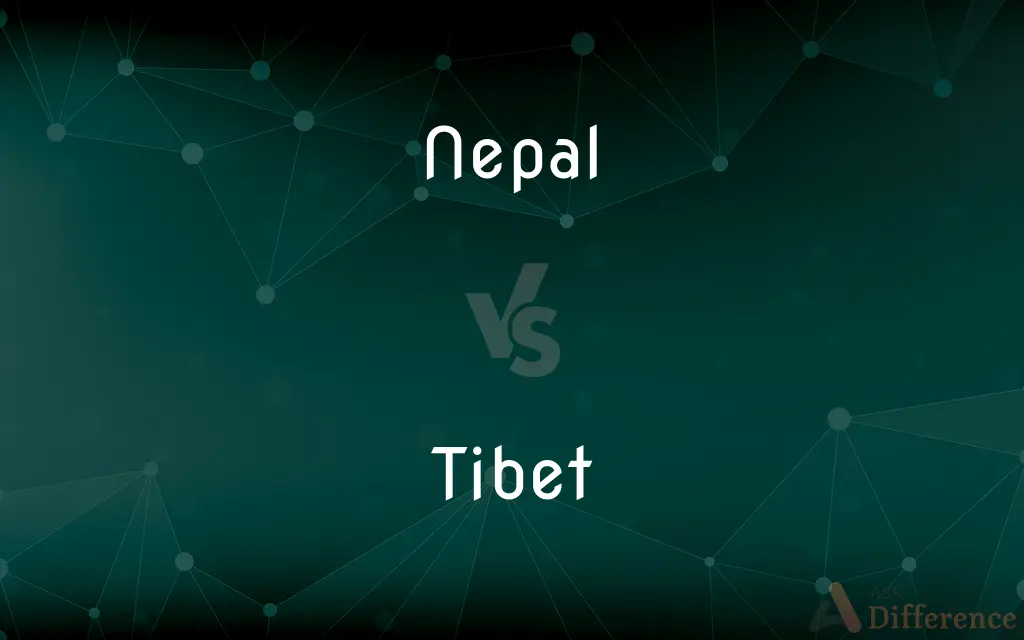Nepal vs. Tibet — What's the Difference?
By Tayyaba Rehman & Maham Liaqat — Updated on March 27, 2024
Nepal is a sovereign country in South Asia, known for its diverse geography including Mount Everest. Tibet is a region in China, recognized for its spiritual significance and Tibetan Buddhism.

Difference Between Nepal and Tibet
Table of Contents
ADVERTISEMENT
Key Differences
Nepal, located in South Asia, is bordered by India to the south, east, and west, and China to the north. It's a land of varied topography, from the lowland Terai regions to the towering Himalayas, including Mount Everest, the world’s highest peak. Tibet, on the other hand, is an autonomous region in China, often referred to as the "Roof of the World" due to its high altitude and its location on the Tibetan Plateau. It shares a border with Nepal to the south.
While Nepal is a democratic republic with a multi-ethnic population practicing a variety of religions including Hinduism and Buddhism, Tibet is known for its strong spiritual identity, with Tibetan Buddhism being the predominant religion. The Dalai Lama, Tibetan Buddhism's spiritual leader, is a figure of global significance, though he resides in exile due to political tensions with China.
Economically, Nepal is largely dependent on agriculture, tourism, and remittances from Nepalis working abroad. Its economy is characterized by its rich cultural tourism and adventure tourism, attracting visitors to its historic cities and high-altitude trekking trails. Tibet’s economy, while also featuring agriculture and tourism, is closely integrated with China and benefits from Chinese investment in infrastructure and development projects. Tibetan culture, with its monasteries, meditation practices, and festivals, is a significant draw for tourism as well.
The environment in both regions is striking, with Nepal known for its biodiversity due to its varied climate zones, and Tibet for its rugged terrain and the Tibetan Plateau, which influences climate patterns across Asia. Both regions, however, face environmental challenges, including deforestation, melting glaciers, and water scarcity.
Culturally, Nepal offers a mosaic of ethnic groups with their languages and traditions, while Tibet is renowned for its rich heritage in Buddhist art, literature, and music. Both regions celebrate a variety of festivals, with Losar (Tibetan New Year) being significant in Tibet and numerous Hindu and Buddhist festivals celebrated in Nepal.
ADVERTISEMENT
Despite their differences, both Nepal and Tibet share the Himalayas, contributing to their breathtaking landscapes and the significant challenges of conservation and sustainable development. Their unique cultures, religions, and natural beauty continue to fascinate the world.
Comparison Chart
Location
South Asia, between India and China.
Autonomous region in western China.
Geography
Diverse, from Terai lowlands to Himalayan peaks.
High-altitude plateau, "Roof of the World."
Government
Democratic republic.
Autonomous region under Chinese governance.
Religion
Predominantly Hinduism, with Buddhism.
Predominantly Tibetan Buddhism.
Economy
Agriculture, tourism, remittances.
Agriculture, tourism, Chinese investment.
Cultural Significance
Rich cultural diversity, multiple ethnic groups.
Spiritual center of Tibetan Buddhism.
Environmental Concerns
Biodiversity, deforestation, water scarcity.
Melting glaciers, environmental degradation.
Tourism
Adventure tourism, cultural heritage.
Spiritual tourism, cultural heritage.
Compare with Definitions
Nepal
Known for its cultural and ethnic diversity.
Nepal celebrates festivals from Hindu, Buddhist, and other traditions.
Tibet
Center for Tibetan Buddhism and spirituality.
The Potala Palace in Lhasa is a historic and spiritual landmark.
Nepal
A republic with a rich history of kingdoms and dynasties.
The Kathmandu Valley is dotted with historic palaces and temples.
Tibet
The "Roof of the World" with a unique landscape.
The Tibetan Plateau offers breathtaking views and challenging terrain.
Nepal
A diverse country with the world's highest peak, Mount Everest.
Nepal attracts climbers from around the globe aiming to summit Everest.
Tibet
Has a distinct language and script.
Tibetan is widely spoken and has its own unique script.
Nepal
Features a mix of agriculture and modern industry.
Nepali tea and coffee are exported worldwide.
Tibet
Rich in traditional arts and literature.
Thangka painting is a revered art form in Tibetan culture.
Nepal
A hotspot for trekkers and adventure seekers.
The Annapurna Circuit offers one of the world’s best trekking routes.
Tibet
Known for its festivals and religious ceremonies.
Losar, the Tibetan New Year, is celebrated with much fanfare.
Nepal
Nepal (English: ; Nepali: नेपाल [nepal]), officially the Federal Democratic Republic of Nepal (Nepali: सङ्घीय लोकतान्त्रिक गणतन्त्र नेपाल), is a landlocked country located in South Asia. It is mainly situated in the Himalayas, but also includes parts of the Indo-Gangetic Plain, bordering Tibet of China to the north, and India in the south, east, and west, while it is narrowly separated from Bangladesh by the Siliguri Corridor, and from Bhutan by the Indian state of Sikkim.
Tibet
Tibet ( (listen); Tibetan: བོད་, Lhasa dialect: [/pʰøː˨˧˩/]; Hindi: तिब्बत; Chinese: 西藏; pinyin: Xīzàng) is a region in East Asia covering much of the Tibetan Plateau spanning about 2,500,000 km2 (970,000 sq mi). It is the traditional homeland of the Tibetan people as well as some other ethnic groups such as Monpa, Tamang, Qiang, Sherpa, and Lhoba peoples and is now also inhabited by considerable numbers of Han Chinese and Hui people.
Nepal
A small landlocked Asian country high in the Himalayas between India and China
Tibet
(archaic) A woolen fabric generally printed in colours; a heavy fabric used for the same purposes as furs, made of goat hair, black and finely curled.
Tibet
An Asian country under the control of China; located in the Himalayas
Common Curiosities
What is Nepal known for?
Nepal is known for its diverse geography including Mount Everest, rich cultural heritage, and as a premier destination for trekkers and climbers.
What are the main religions in Nepal and Tibet?
Nepal has a majority Hindu population with a significant Buddhist minority, whereas Tibetan Buddhism is the predominant religion in Tibet.
What distinguishes Tibet?
Tibet is distinguished by its high-altitude plateau, profound spiritual heritage centered on Tibetan Buddhism, and unique cultural practices.
How do Nepal and Tibet's economies differ?
Nepal’s economy is primarily based on agriculture, tourism, and remittances, while Tibet’s economy also includes agriculture and tourism but benefits significantly from Chinese investment.
Can tourists easily visit Tibet and Nepal?
Nepal welcomes tourists with various visas on arrival for many nationalities, promoting its adventure and cultural tourism. Visiting Tibet requires a special permit from the Chinese government, in addition to a Chinese visa, due to its autonomous status and sensitive political situation.
How are Nepal and Tibet culturally unique?
Nepal boasts a mosaic of ethnic groups and festivals, while Tibet is known for its spiritual practices, Buddhist monasteries, and traditional arts.
What environmental challenges do Nepal and Tibet face?
Both face environmental challenges such as melting glaciers and water scarcity. Nepal also deals with deforestation, while Tibet’s concerns include environmental degradation due to development projects.
What is the significance of the Himalayas to Nepal and Tibet?
The Himalayas are central to the identity, culture, and economies of both Nepal and Tibet, offering natural resources, spiritual inspiration, and attracting tourism.
What role does religion play in the governance of Nepal and Tibet?
Religion significantly influences the culture in both regions, but Nepal operates as a secular republic, whereas Tibet’s governance under China restricts religious expression and promotes secularism.
How does altitude affect life in Nepal and Tibet?
High altitudes in both regions result in thinner air and colder temperatures, influencing local lifestyles, agriculture, and architecture, with adaptations for high-altitude living.
Share Your Discovery

Previous Comparison
Dis vs. Diss
Next Comparison
Epithelialization vs. GranulationAuthor Spotlight
Written by
Tayyaba RehmanTayyaba Rehman is a distinguished writer, currently serving as a primary contributor to askdifference.com. As a researcher in semantics and etymology, Tayyaba's passion for the complexity of languages and their distinctions has found a perfect home on the platform. Tayyaba delves into the intricacies of language, distinguishing between commonly confused words and phrases, thereby providing clarity for readers worldwide.
Co-written by
Maham Liaqat














































